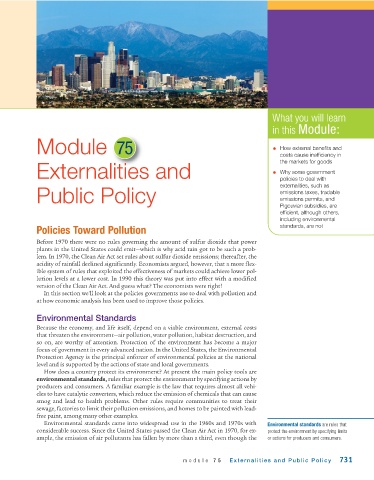Page 773 - Krugmans Economics for AP Text Book_Neat
P. 773
What you will learn
in this Module:
Module 75 • How external benefits and
costs cause inefficiency in
the markets for goods
Externalities and • Why some government
policies to deal with
externalities, such as
Public Policy emissions taxes, tradable
emissions permits, and
Pigouvian subsidies, are
efficient, although others,
including environmental
standards, are not
Policies Toward Pollution
Before 1970 there were no rules governing the amount of sulfur dioxide that power
plants in the United States could emit—which is why acid rain got to be such a prob-
lem. In 1970, the Clean Air Act set rules about sulfur dioxide emissions; thereafter, the
acidity of rainfall declined significantly. Economists argued, however, that a more flex-
ible system of rules that exploited the effectiveness of markets could achieve lower pol-
lution levels at a lower cost. In 1990 this theory was put into effect with a modified
version of the Clean Air Act. And guess what? The economists were right!
In this section we’ll look at the policies governments use to deal with pollution and
at how economic analysis has been used to improve those policies.
Environmental Standards
Because the economy, and life itself, depend on a viable environment, external costs
that threaten the environment—air pollution, water pollution, habitat destruction, and
so on, are worthy of attention. Protection of the environment has become a major
focus of government in every advanced nation. In the United States, the Environmental
Protection Agency is the principal enforcer of environmental policies at the national
level and is supported by the actions of state and local governments.
How does a country protect its environment? At present the main policy tools are
environmental standards, rules that protect the environment by specifying actions by
producers and consumers. A familiar example is the law that requires almost all vehi-
cles to have catalytic converters, which reduce the emission of chemicals that can cause
smog and lead to health problems. Other rules require communities to treat their
sewage, factories to limit their pollution emissions, and homes to be painted with lead-
free paint, among many other examples.
Environmental standards came into widespread use in the 1960s and 1970s with Environmental standards are rules that
considerable success. Since the United States passed the Clean Air Act in 1970, for ex- protect the environment by specifying limits
ample, the emission of air pollutants has fallen by more than a third, even though the or actions for producers and consumers.
module 75 Exter nalities and Public Policy 731

